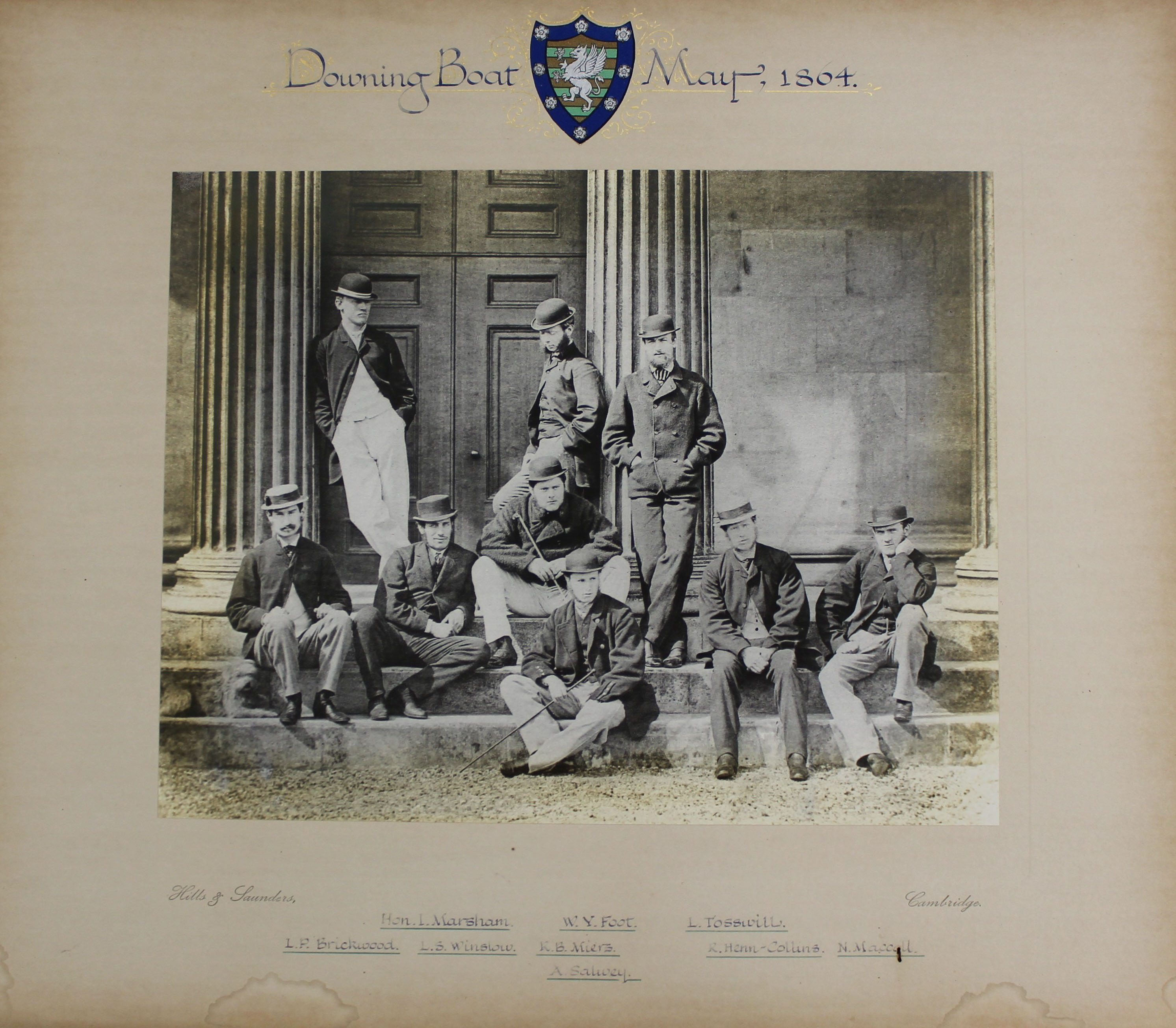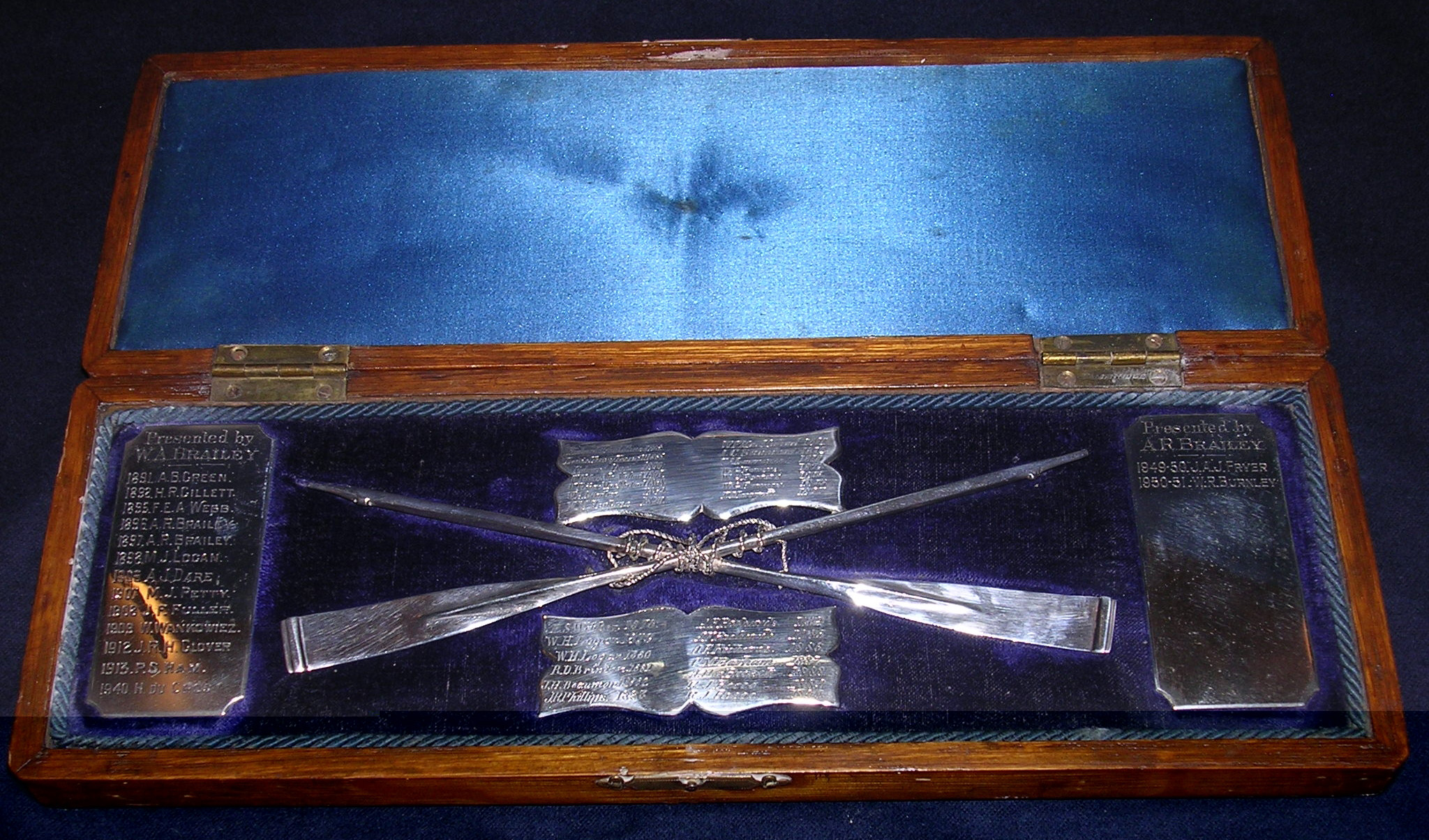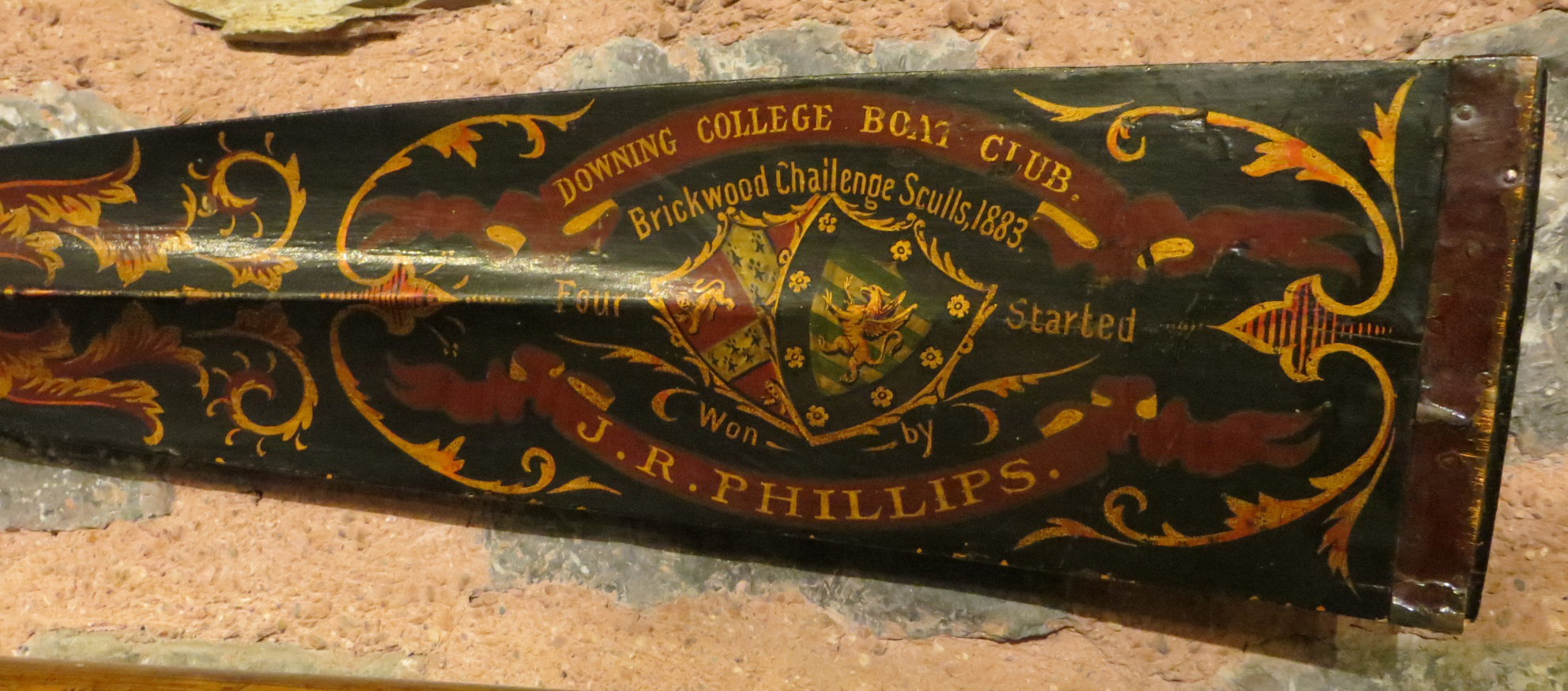The first ever Downing May Boat, 1864
The first ever Downing May Boat, 1864
Just before Christmas 2018 the College received a package containing a framed photograph of the first ever Downing May Boat crew, 1864, taken when the Boat Club was less than a year old and the College had only a handful of students. (The photograph was apparently removed from the College in the 1960s by an Oxford student and returned anonymously, with sincere apologies, to the Head Porter). The College sends its thanks for the safe return of such an important item of great significance to the history of the College and the Boat Club. The photograph has since been conserved so that a copy can be made for display in College or at the Boathouse.

This is the earliest known surviving photograph showing Downing students. The Boat Club had only just been formed, in late 1863, proposed by John Buckley Bradbury (later to be the last Downing Professor of Medicine) and seconded by Richard Henn Collins, an Irishman and one of the first new Foundation Scholars admitted in October 1863. (The recent introduction of scholarships and exhibitions enabled by a change in the College’s statutes had resulted, in October 1861, in the admission of the first new ‘pensioners’ (normal undergraduates) at Downing for more than thirty years!)
Henn Collins was elected Secretary of the new Boat Club, with Latham Christopher Norris Percy Brickwood elected the first Captain. One of his first acts was to present a trophy to be competed for by Downing rowers, the ‘Brickwood Challenge Sculls’. Its first winner was Richard Henn Collins and the silver oars, with accompanying plaques recording each year’s winner, are still held by the College today.

Interestingly, an alumnus came across the 1883 winning Brickwood Sculls oars, awarded to J. R. Phillips, in the Rahmi M Koc Museum in Istanbul a few years ago. Many thanks to him for sending in photographs!

Downing made its debut in the 1864 Lent Bumps, with no official colours and racing with violet blades with black Maltese crosses, starting twelfth in the third division. They made an admirable start, going up two in the Lents, and ending the Mays as head of the third division and sandwich boat - a remarkable achievement given the club was still less than a year old. Read more about the early history of the Boat Club.
Significantly, this 1864 photograph includes more than half the student population of the College at that time, and so it is an especially exciting addition to the College Archive collection. Eight of the nine students pictured had come up to Downing since April 1863 – four of them in the months after the formation of the Boat Club (extract from the Admissions Register below). Four of the crew had migrated from other Colleges and two (Richard Henn Collins and Norman Maccoll) went on to become Downing Fellows.

Richard Henn Collins matriculated in 1863 as a Foundation Scholar in Classics. He graduated in 1865 and was elected a non-resident Fellow in October that year. He was called to the Bar in 1867, becoming Queen’s Counsel in 1883 and was elected an Honorary Fellow at Downing in 1885. In 1891, he was appointed to the Queen’s Bench Division of the High Court and presided over Oscar Wilde’s famous libel trial against the Marquis of Queensberry in April 1895 (an unwise act by Wilde which ultimately led to his own imprisonment). He was appointed to the Court of Appeal in 1897, made Master of the Rolls in 1901 and promoted to the Judicial Committee of the House of Lords in 1907 when he assumed the title of Lord Collins of Kensington.
Norman Maccoll migrated to Downing from Christ’s College in October 1863. He graduated in 1866 as a Scholar (Moral Sciences, 1st Class), won the prestigious Hare Prize in 1868 and was elected a Fellow of Downing the following year, a position he held until 1881. He was Editor of The Athenaeum from 1871 to 1900, was admitted to Lincoln’s Inn in 1872 and called to the Bar in 1875. He later endowed the Norman Maccoll Lectureship in Spanish and Portuguese at Cambridge University, which still exists today.
Short biographies of the other students pictured follow:
The Hon. John Marsham was admitted a pensioner in April 1864, from Christ’s Church, Oxford and Eton. The second son of Charles, 3rd Earl of Romney, and Lady Margaret (daughter of the 4th Duke of Buccleuch), he graduated in 1866, the year he was ordained as a deacon (and as a priest the following year). He served as a curate until 1868 before becoming rector of Barton Seagrave, Northamptonshire, where he remained for 40 years, followed by a short time as rector and archpriest at Haccombe, Devon.
William Yates Foot was admitted a Fellow-Commoner in March 1862 from Rossall School, matriculating in Michaelmas 1862. He graduated in 1866, the year he was ordained as a deacon, and was ordained as a priest in 1867. He was curate-in-charge of Ashford Carbonell, Salop from 1867-72 and Vicar of Moulsford, Berkshire from 1879-89.
Louis Henry Tosswill matriculated at Gonville and Caius in 1862 before migrating to Downing in January 1864, studying Medicine. He was House Surgeon and Physician at St Bartholomew’s Hospital, London before a long medical career in Exeter.
Latham Christopher Norris Percy Brickwood matriculated as a pensioner in April 1863, studying Law, and was admitted to the Inner Temple the following month. He graduated BA and LL.B in 1866 and was called to the Bar in 1867, acting mainly on the South Eastern Circuit.
Lyttleton Stewart Winslow (later Forbes-Winslow) matriculated at Gonville and Caius in 1862, before migrating to Downing (with Louis Tosswill) in January 1864. He was a physician and recognised expert on insanity and mental disorders. He was the founder, consulting physician and director of the British Hospital for Mental Disorders, London.
Robert Bonnor Miers matriculated at Trinity in October 1862, migrating to Downing as a Fellow-Commoner in March 1864. Sadly, he died suddenly on 29 May 1866, before graduating.
Alfred Salwey was admitted as a Fellow-Commoner, June 1863, matriculating the following term. He was Chairman of the Quarter Sessions in Shropshire and a JP in Shropshire and Herefordshire.
Image credits
1864 May Boat photograph – reproduced with kind permission of Hills & Saunders (and with thanks to the Cambridge Colleges’ Conservation Consortium)
Brickwood Sculls oar – with thanks to Paul Hopper (1964)
